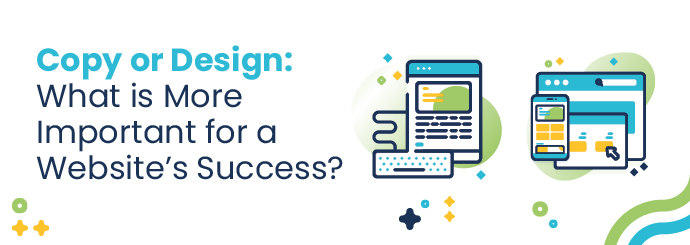
Which is more important to a website's success: the actual content, or how it looks? Copy vs design is a topic that's sparked much debate among website designers, copywriters and digital marketing professionals.
Some people will tell you that innovative design is more important because first impressions are everything, and besides, most people don't even bother to read the text on the websites they visit!
Alternatively, others argue that content is king, and that even the most beautiful website won't perform very well if there's no substance to it.
But our opinion is that content and design are equally important - a website needs both to succeed. And here's why...
1. You need high-quality content to rank on Google
Your site's content should be unique, specific and high-quality. Ultimately, effortless copy contributes to your target audience's overall user experience of your website, which is a contributing factor for search engine rankings.
It's integral that your copy is of high value - your copy should aim to increase the visitor's understanding of a topic, or a service, in a way that they hadn't seen or considered it before. You should aim to offer a new and fresh perspective, which sets your website apart from competitors.
2. Good design needs good content (and vice versa)
It's all well and good to have a flashy design, but what use does that give the user if your content is jumbled and illegible? The juxtaposition of the two can create confusion for the user, resulting in a negative perception of your business - that's really not what you want!
Ensure that your copy complements and interlaces with your design to portray a strong brand image to your target audience.
3. If you focus on design too much, you could sacrifice your loading times
If your site loads in 2.9 seconds, it's faster than 50% of the web! Page load time is a ranking factor, and it's an essential metric for SEO (Search Engine Optimisation) purposes.
Impatience is the most reliable trait of the modern web-user, and elaborate design can increase your site's loading time. Here are a few design-tips to consider to reduce your page's loading time:
- Avoid rare and obscure fonts
- Be careful with social media buttons as they can create latency
- Consider making the load-time engaging with animations (like Skeleton screens!)
This is where copy can take the crown - if you have light and streamlined copy that focuses on your user's search intent straight away, your loading times will inevitably be shorter due to the focus on copy, and your user will be satisfied with the information that they were looking for.
4. An ugly website can automatically turn people off
With design, it's all about finding that perfect middle ground. Too much, and you can sacrifice your page's loading speed and potentially overwhelm the user. Too little, and you can give your target audience the wrong impression of your website.
Finding the 'goldilocks zone' of design is your best bet here. Ensure that your design encapsulates your brand values, your brand voice, and the personality that you want to depict - remember that sometimes, less is more. If you go overboard, your design can easily get messy and difficult to navigate.
Always think about what is essential and ensure that every design aspect has its own specific purpose, tailored to the needs of your desired user.
5. The way you present information is just as important as the information itself
Good presentation reflects the quality of the content - it's important that your copy is positioned as high-quality, informative, and reliable. You can do this through utilising design to complement the contents of your copy.
People love nice-looking, aesthetic things - users are more likely to trust your business, and feel connected to your cause (and feel persuaded to connect with you) if your website looks professional and authentic.
6. Design is a huge contributor to brand identity
Brand identity is the visual representation of your business. Think about your target audience and how you want them to see you - your brand identity should encapsulate this.
Design collates the use of colour, shape and placement to create an image of your brand in your desired user's mind - it's a huge asset for persuasion and creating a connection with an audience, resulting in more conversions, brand awareness and brand engagement.
So, is one better than the other?
As you can see, both copy and design are essential in different ways. Ultimately, they should be considered in the website-building process as equals - if you lack in one aspect, the other will suffer.
The best thing to do is entwine your copy and design to give the strongest and most effective impression of your business, to highlight everything you value and stand for as a brand.
Need more advice?